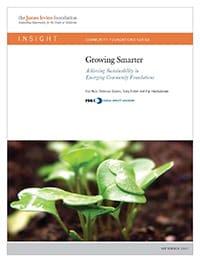Emerging community foundations face unique opportunities and challenges when trying to achieve sustainable growth. Analysis with 9 community foundations, supported by the James Irvine Foundation’s Community Foundation Initiative II, illustrates valuable lessons and approaches for community foundations of virtually any size that are undergoing a significant increase in scale of assets, operations, or operating costs.
Top Takeaways
- Emerging community foundations face unique opportunities and challenges, are distinctively different from larger, more established foundations, and have the ability to adapt more quickly and innovate more freely.
- Community foundation sustainability does not depend on growth alone. Answering the right questions in the right order and choosing an approach to growth that aligns organizational resources and expectations will increase the likelihood for success.
- There is no single right solution that applies to all community foundations’ growth.
- The experiences of community foundations, and related research, point to 3 prevailing approaches that lead to sustainable patterns of growth. These approaches can be characterized as controlled, engaged, and leveraged. Successfully employing any of these 3 approaches depends on understanding the community foundation’s economics.



